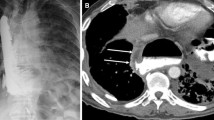Abstract
Esophageal rupture is a surgical catastrophe. The gold standard for diagnosing is iodine, water-soluble contrast medium esophagography. CT esophagography has shown promising results. This study aimed to assess the diagnostic performance of CT esophagography in patients with a suspicion of esophageal rupture. This prospective study assessed the performance of a diagnostic test and was approved by local IRB committee. Patients who presented with a clinical suspicion of esophageal rupture were included. CT esophagography findings were described by the emergency radiologist. Clinical outcomes (presence or absence of esophageal rupture) were reported by surgeons. The operative characteristics were calculated. A final predictive scale for rupture was built. A total of 64 patients were recruited (age 26.5 years, 90 % male, 82 % trauma). Sensitivity, specificity, and positive and negative likelihood ratios (LRs) were 77.7 % (95 % confidence interval (CI) 45–100), 94.3 % (87.2–100), 14 (9.81–19.9), and 0.24 (0.05–1.22), respectively. The final model for predicting rupture included five variables: age (odds ratio (OR) 1.03; 95 % CI, 0.95–1.11; p = 0.04), leakage of contrast media into the mediastinum or pleural space (OR 10.0; 95 % CI, 0.64–156.9; p = 0.10), extraluminal air or fluid collections (OR 43.1; 95 % CI, 1.52–1217.3; p = 0.027), esophageal wall thickening (OR 10.1; 95 % CI, 0.50–202.8; p = 0.12), and left pneumothorax or pleural effusion (OR 6.5; 95 % CI, 0.31–132.7; p = 0.2). The overall agreement was 0.40 (95 % CI, 0.09–0.72) for the predictive model. The model sensitivity was 50.0 %, and the specificity was 98.4 %. CT esophagography shows a good diagnostic performance in patients with a suspected esophageal rupture.




Similar content being viewed by others
References
Vogel SB, Rout WR, Martin TD et al (2005) Esophageal perforation in adults: aggressive, conservative treatment lowers morbidity and mortality. Ann Surg 241:1016–1021
Kiernan PD, Sheridan MJ, Elster E et al (2003) Thoracic esophageal perforations. South Med J 96:158–163
de Lutio di Castelguidone E, Merola S, Pinto A et al (2006) Esophageal injuries: spectrum of multidetector row CT findings. Eur J Radiol 59:344–348
Backer CL, LoCicero J III, Hartz RS et al (1990) Computed tomography in patients with esophageal perforation. Chest 98:1078–1080
Flynn AE, Verrier ED, Way LW et al (1989) Esophageal perforation. Arch Surg 124:1211–1214
Rubesin SE, Levine MS (2003) Radiologic diagnosis of gastrointestinal perforation. Radiol Clin N Am 41:1095–1115, v
Fadoo F, Ruiz DE, Dawn SK et al (2004) Helical CT esophagography for the evaluation of suspected esophageal perforation or rupture. AJR Am J Roentgenol 182:1177–1179
White CS, Templeton PA, Attar S (1993) Esophageal perforation: CT findings. AJR Am J Roentgenol 160:767–770
MACKLER SA (1952) Spontaneous rupture of the esophagus; an experimental and clinical study. Surg Gynecol Obstet 95:345–356
Kim SH, Kim YJ, Lee JM et al (2007) Esophageal varices in patients with cirrhosis: multidetector CT esophagography—comparison with endoscopy. Radiology 242:759–768
Brick SH, Caroline DF, Lev-Toaff AS et al (1988) Esophageal disruption: evaluation with iohexol esophagography. Radiology 169:141–1-43
Conflict of interest
The authors declare that they have no conflict of interest.
Author information
Authors and Affiliations
Corresponding author
Rights and permissions
About this article
Cite this article
Suarez-Poveda, T., Morales-Uribe, C.H., Sanabria, A. et al. Diagnostic performance of CT esophagography in patients with suspected esophageal rupture. Emerg Radiol 21, 505–510 (2014). https://doi.org/10.1007/s10140-014-1222-4
Received:
Accepted:
Published:
Issue Date:
DOI: https://doi.org/10.1007/s10140-014-1222-4




